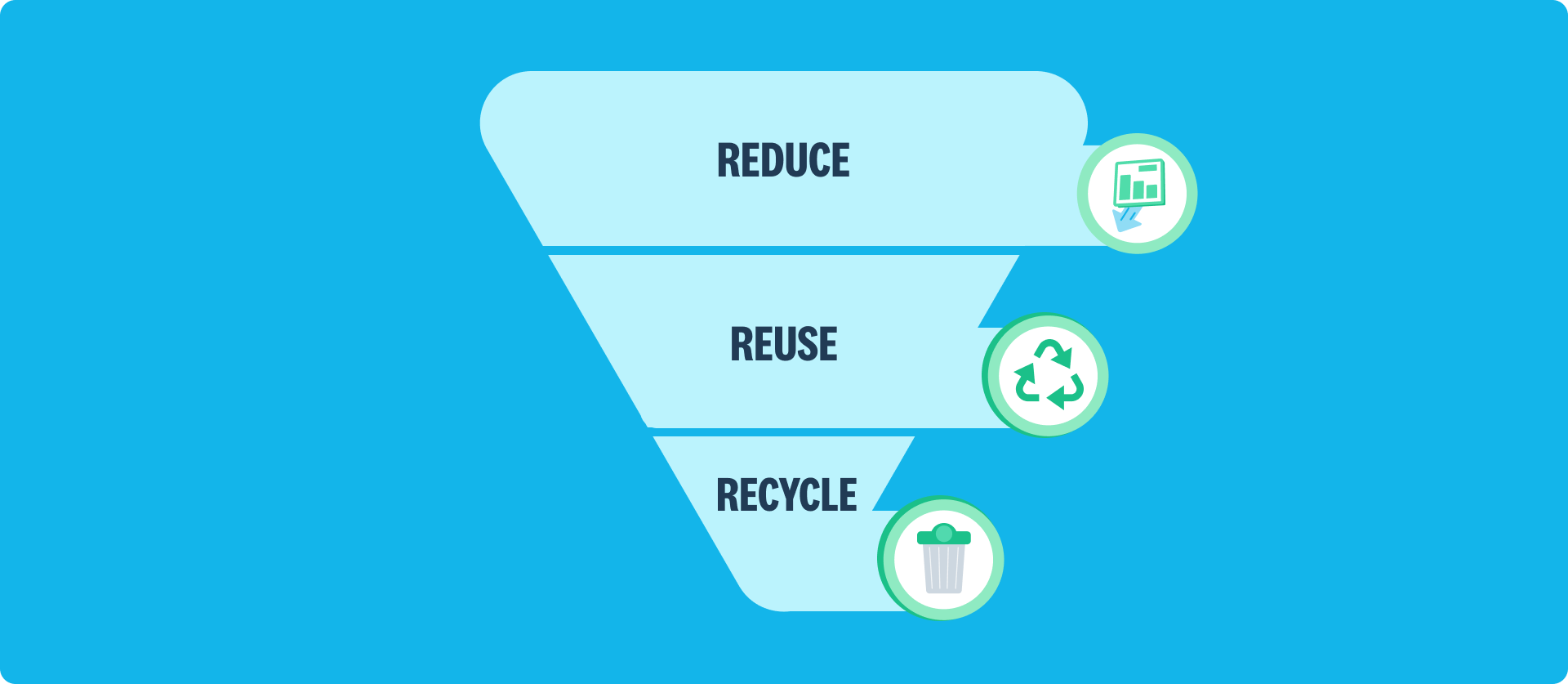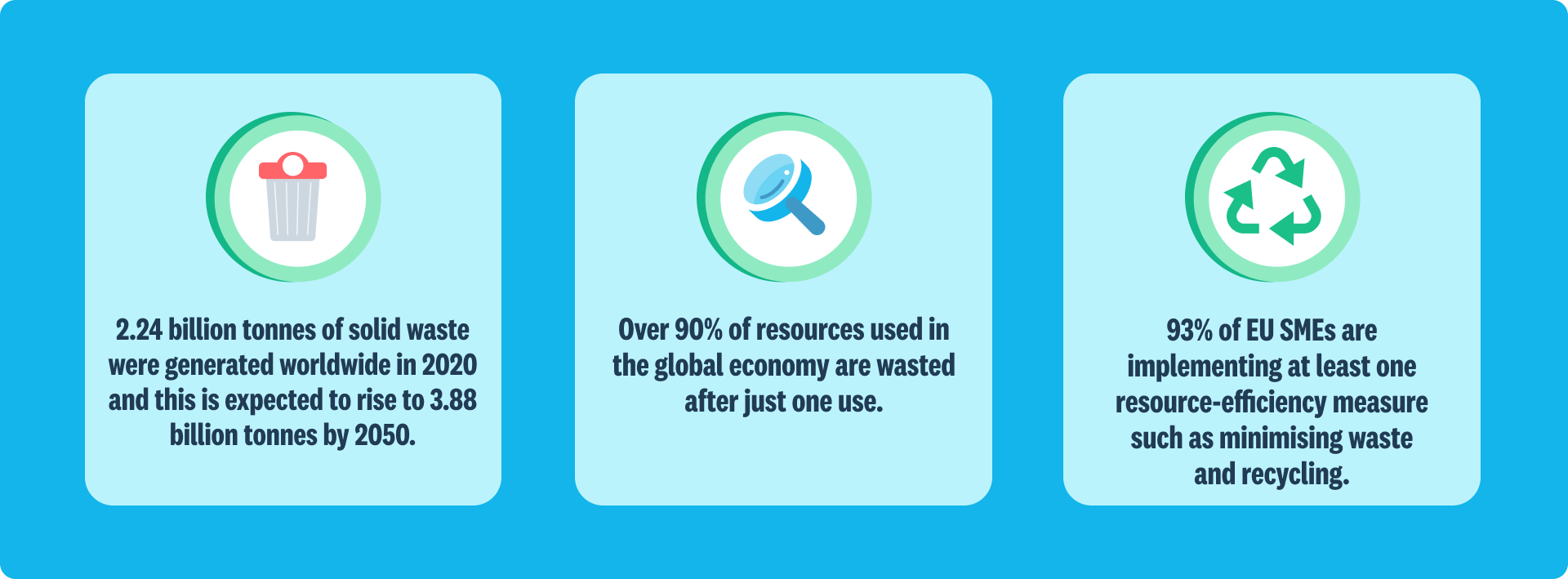Operational waste
How to cut waste, save money and get the most value out of your resources.

In this topic
What it is
Spoiled stock, unsold merchandise, offcuts, single-use items: these, on their own, might seem like a small addition to the waste bin. But across your business, waste can quietly pile up and cost you more than you think.
Sometimes it’s obvious, like piles of delivery boxes and plastic out the back. Other times it’s hidden in the cost of things you bought but never used. This guide shows practical steps you can take to reduce waste, reuse materials, and recover more value across your business operations.

Why it matters
Waste is no longer out of sight and out of mind. Every year, billions of tonnes of waste are generated globally, most of it by businesses and industries. And while the most visible impact may be piles of waste in landfill or waterways, the real impact starts long before that.
Every item you throw away has already used up energy, water, land and raw materials in being made and shipped around the world. That means emissions, pollution, and environmental damage, all without any benefit if the item ends up in the bin.
Once discarded, waste continues to cause problems. Landfills take up land, release methane (a powerful greenhouse gas), and can pollute groundwater. And plenty of waste, especially plastic, never makes it to landfill. It ends up in nature, harming wildlife and breaking down into microplastics that enter our food and bodies.
Reducing waste cuts resource use, emissions and environmental harm. It also saves money, space, and can be a visible way to show your business is doing its part.

Who it matters most for
Waste is a major concern for businesses that handle materials, stock, or food, like manufacturers, retailers, construction, and events and hospitality venues. Other businesses that deal with lots of packaging, use single-use items, or generate organic waste, can also have a high waste impact.
Even office-based and professional services businesses use paper, supplies, and packaging. Most generate at least some food, electronic or promotional waste. Reducing operational waste is something every business can do, and it often starts with small, simple changes that add up over time.
What you can do
Here are some practical and impactful ways you can address this topic in your business.
Reduce waste at the source
The best way to reduce waste is to avoid creating it in the first place. Waste can come from over-ordering, poor forecasting, inefficient production or items being damaged, spoiled or unused. Small tweaks in how your business orders, stores, uses and handles materials can prevent large amounts of waste, and save money too.
For example, retail businesses can improve inventory management and forecasting to avoid excess stock that goes unsold. Manufacturers can apply lean production to minimize offcuts, errors and rejects, as well as minimize hazardous waste by switching to safer inputs and methods. Construction businesses can plan more precisely and use pre-built components to reduce site waste. Even service businesses can go digital to avoid paper waste. Wherever waste is being generated, look upstream for a smarter way to avoid it.

Source: WRI 2024
Quick actions you can take:
- Avoid food spoilage through better storage and inventory management
- Order stock and materials more precisely to avoid surplus
- Apply lean manufacturing to reduce material waste and defects
Switch from single-use to reusables
Single-use items are one of the most common and visible sources of waste and one of the easiest to avoid. Whether it’s takeaway cups, paper towels, plastic wrap, liners or coffee pods, reusables often deliver better value over time.
In food service and tourism, switching to reusable cutlery, cups, napkins and containers not only cuts waste but can create a premium guest experience. In office kitchens you might have to set clear washing up rules, but your employees will appreciate real mugs and refillable drink bottles. Even in environments where hygiene is critical, like health and beauty services, you can find reusable options for items like gowns, applicators, and sharps containers, provided they’re used and sanitised properly.

Source: UNEP 2021
Quick actions you can take:
- Swap out disposable cups, cutlery, napkins and plates in food service
- Provide reusable mugs, glasses and water bottles in office kitchens and tea rooms
- In health and beauty settings, use textiles, instruments and applicators that can be washed and sanitised
Improve waste sorting and resource recovery
Most of us have tossed something in the wrong bin, whether due to inattention or confusion over what goes where. But this leads to recyclable or compostable materials ending up in landfill unnecessarily.
Reviewing the contents of your bins, also known as doing a waste audit, can help you understand what you're throwing away and what could be recycled or redirected instead. It's important to identify what items can go in the recycling or organics bin according to your local waste provider by checking their website, as this can vary.
Some items, such as paint, soft plastics, printer cartridges, blister packs, even hair trimmings, may not be allowed in those bins but can still be sent to specialty recyclers. Check out local programs through government and waste providers, and look for industry initiatives, or you could even join forces with others in your area to establish a collection point.
Finally, make it easy for your staff to do the right thing by setting up bins where that waste is generated, providing clear signage (even with photos) and encouraging the right behaviour.

Source: Jim’s Skip Bins
Quick actions you can take:
- Identify and segregate recyclable and compostable wastes
- Partner with specialist recyclers and resource recovery programs for other items
- Support your staff and customers to segregate waste into the right bins
Give waste and by-products a second life
They say one person's waste is another's treasure, so what if that item doesn't need to be thrown away at all? Many types of waste can be reused, repurposed or resold if you think creatively and connect with the right partners.
Depending on the item, there can be different channels. Unsold or imperfect but usable stock like apparel, food, toys and personal products can be donated to charities or community groups. Manufacturing by-products like offcuts or packaging can be used by other local businesses. If you end up with damaged goods, consider repair or resale instead of disposal.
Check out local exchange networks such as Buy Nothing groups and reuse initiatives; you might even find your waste is in high demand!

Quick actions you can take:
- Donate unsold products and imperfect goods
- Repurpose manufacturing and construction offcuts and byproducts
- Connect with exchange networks, reuse initiatives or secondary markets
Cut waste from deliveries
Packaging is a major source of waste in our bins, especially in businesses that receive lots of goods and materials. With every delivery, the pile of plastic and cardboard out back seems to grow.
Rather than simply recycling, you can work with suppliers to reduce the packaging. Some packaging can be avoided entirely, like plastic sleeves; or it can be lighter in weight, the number of layers reduced, or it can be replaced with more readily recyclable materials like paper. Some items can even be provided in bulk without individual packaging, like building materials and cleaning products, or in returnable containers, like food ingredients, as well as returnable pallets, crates, nets, even spools.
Some suppliers may resist at first, but these practices are growing increasingly common as their customers demand it. Many suppliers now even offer programs to take back their used products like e-waste and uniforms.

Source: OECD, 2022
Quick actions you can take:
- Request minimal or more recyclable packaging from suppliers
- Buy in bulk to reduce packaging required
- Find suppliers who use returnable packaging, pallets, crates, and so on
Compost organic waste and green materials
Organic waste, including food scraps, flowers, green clippings, even animal waste, breaks down naturally, but still creates emissions in landfill. Composting and reusing organics creates value instead, keeping those nutrients in the food cycle.
For some businesses, the local council or waste provider may offer pickups. For others, solutions may depend on the volume and type of the waste, ranging anywhere from small-scale on-site bins like worm farms to large in-vessel composters. As a small business, it helps to collaborate with others in your area, perhaps to consolidate your waste to better manage it or to find local community gardens that would love the compost or wood mulch!

Source: NSW EPA 2024
Quick actions you can take:
- Set up composting collection for food and green waste
- Collaborate with others to consolidate your waste or find end users
Design for circularity and end-of-life
The way you design your spaces, events, products or packaging has a big impact on how much waste they generate in their lifetime. This doesn't directly cause waste for your own operations but for your customers, so is addressed further in the how-to-guide on products and sourcing.
Design with longevity, reuse and recyclability in mind. Whether it's modular structures, easy-to-disassemble fixtures, or materials with clear recycling pathways, thinking ahead reduces future waste and supports a more circular economy.

Source: OECD 2025
Quick actions you can take:
- Design products and packaging for disassembly, repair and ease of recycling
- Design interiors, displays and structures for disassembly, reconfiguration and reuse
How to know if it’s working
The most common ways to measure progress on operational waste involve ascertaining how much waste your business produces in total, and how much of that goes to landfill or gets recovered for circular uses.
Specifically:
- Total waste generated: Measured in weight (eg, kilograms) or volume (eg, cubic metres)
- Waste to landfill: How much ends up in landfill
- Diversion rate: The percentage of waste that’s recycled, composted or reused. You can calculate the diversion rate as: (Recycled + Reused + Composted) ÷ Total Waste × 100%
To get these numbers, you can use waste collection invoices, bin audits or estimates based on bin size and frequency they have to get emptied. By tracking these over time and implementing the above strategies, you'll watch diversion rates rise and disposal costs drop.
To really drive improvement, many businesses set themselves a diversion target such as 80% or 90%, or even ‘zero waste to landfill’.
See it in practice
Learn how Xero customer Kapdaa reduces waste across the fashion and interior design industries by improving sorting and recycling and ensuring beautiful fabrics and unwanted garments can be reused.
Watch their story
How to learn more
Definitions, guiding principles, certification and further learning resources to pursue zero waste in business.
Zero Waste International AllianceDefinitions, guiding principles, certification and further learning resources to pursue zero waste in business.
Zero Waste International AllianceA simple guide to reviewing and reducing waste from commercial buildings.
Managing waste from buildings: Action guideA simple guide to reviewing and reducing waste from commercial buildings.
Managing waste from buildings: Action guideHigh level guide to why to care, how to take action, how to measure, and some examples.
Why Should You Care About Preventing Waste? Small Business GuideHigh level guide to why to care, how to take action, how to measure, and some examples.
Why Should You Care About Preventing Waste? Small Business GuideGuides your business through assessing its waste, creating an action plan based on tailored recommendations and tracking progress.
Bin Trim (AU)Guides your business through assessing its waste, creating an action plan based on tailored recommendations and tracking progress.
Bin Trim (AU)Designed to help UK business comply with waste regulation but helpful worldwide; provides industry-specific guidance and a waste audit template.
The Business of Recycling (UK)Designed to help UK business comply with waste regulation but helpful worldwide; provides industry-specific guidance and a waste audit template.
The Business of Recycling (UK)